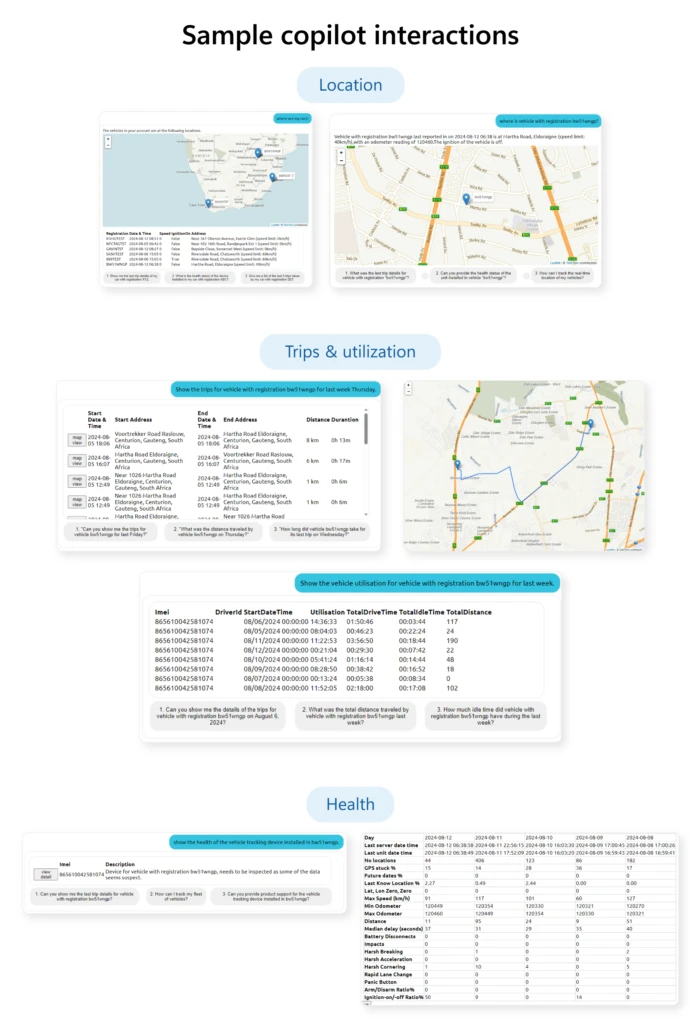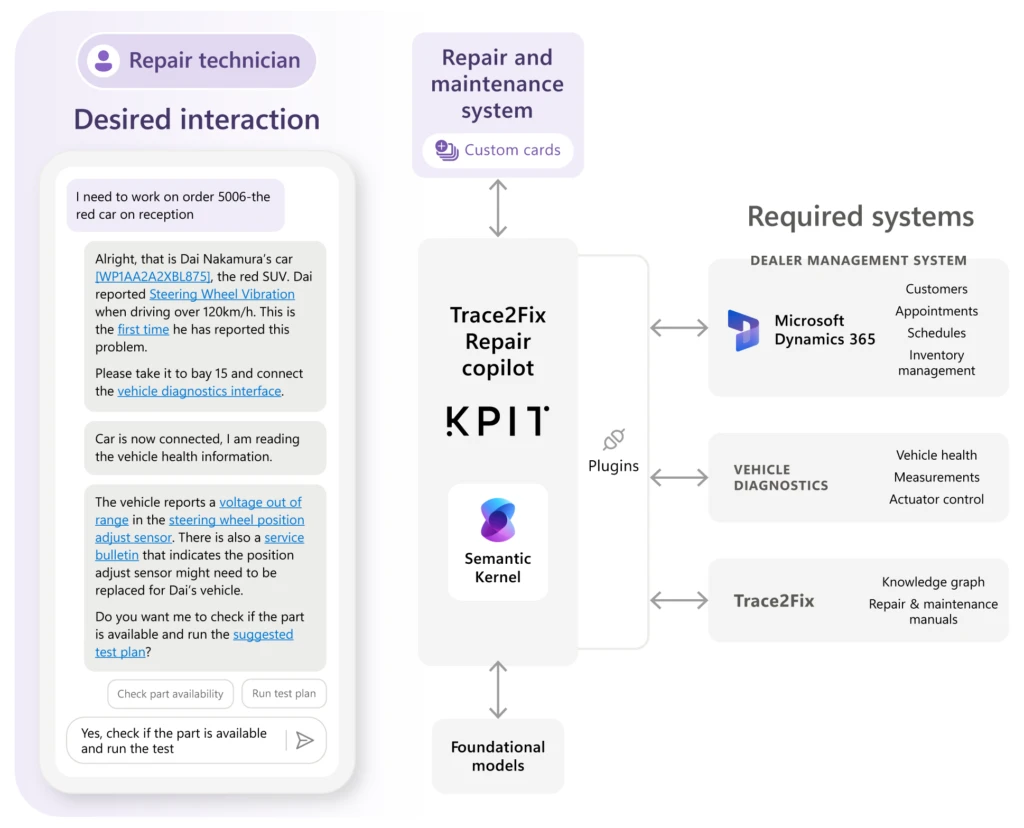
Accelerating the automotive sector with mobility copilots
At any given time, a company has thousands of people making decisions based on data and using various applications to run their business. These information workers often need multiple systems to achieve their goals, ranging from specialized applications to systems of record and productivity tools. Making decisions to optimize business operations requires accessing the right information at the right time.
Generative AI is revolutionizing the way that people interact with their applications. Microsoft is at the forefront of this change by integrating Microsoft Copilot into its products and empowering customers and partners to build their own copilot experiences. Today, copilots have been developed to enhance the productivity of industry functions and roles. These copilots synthesize data from multiple systems, providing information workers with streamlined access to data that can lead to faster, better decision-making and empowers the workforce.

Microsoft for mobility
Power the future of mobility with trusted solutions for automotive, travel, and transportation
The power of mobility copilots
In the automotive industry, information workers are found across many business functions: research and development, manufacturing, sales, digital experiences, after-sales, and commercial operations. Information workers have different roles and tasks, for example:
- Requirement engineers: Define functions of the vehicle based on market requirements.
- Software developers: Create new software defined vehicle functions.
- Fleet operators: Operate mobility services and fleet operations for commercial operations using fleet management solutions.
- Repair and maintenance technicians: Provide repair and maintenance services in the workshop.
A function-based copilot can leverage multiple systems to provide a unified user experience for increasing productivity. To be more effective, the copilot user experience can be optimized for each type of end-user depending on the nature of their tasks and work environments. For example, the copilots run in different types of applications, devices, and uses, such as, end-user programs, desktop computers, mobile applications, or as voice only assistants—requiring different types of user interactions. Application and data integration in automotive can be complex as the ecosystem of software vendors create specialized data and applications that address industry-specific needs, such as functional safety and compliance during development, and right-to-repair regulation for after sale.

For connecting, ingesting, and analyzing mobility and industrial data, organizations can use Microsoft Azure data analytics and messaging services such as Microsoft Fabric, Real-Time Intelligence, and Event Grid, to process streaming data from different kinds of devices, from vehicles to robots. Furthermore, Copilot, available across the Microsoft stack in trusted products such as Dynamics 365, Microsoft 365, and Microsoft Teams, can promote additional collaboration, and increase productivity.
The latest mobility partner copilots
Microsoft Industry Clouds is redefining the way industries operate, with tools and guidance to support partners in the creation of industry copilots. Mobility-specific reference architectures are available to help to plan and build complete solutions. As part of the Microsoft commitment to empowering a global partner ecosystem of industry experts, we work closely with partners to build solutions based on customer pain points. Microsoft recently collaborated with industry partners, Netstar and KPIT, to create copilots that address concrete needs in the automotive industry. These solutions will soon be available in Azure Marketplace:
- Netstar has created a fleet operations copilot that simplifies the work of the fleet manager by interacting with vehicle, driver, and task management subsystems.
- KPIT has created a repair and maintenance copilot that enables repair and maintenance workers to fix vehicles faster, at first visit, thus increasing customer satisfaction.
Fleet operations copilot from Netstar

Fleet operators need to focus on operational efficiency to maintain and increase business profits—this means making quick decisions on vehicles, driver allocations, schedules, and tasks to optimize cost. Furthermore, to obtain a comprehensive view of the operation while in the office and on the move, a fleet manager relies on information from multiple systems.
Netstar has created a copilot that integrates different systems to provide a unified experience that enables fleet managers to extract relevant information quickly and make decisions grounded on data insights in a short amount of time.
The copilot integrates fleet information and telemetry data from the Real-Time Intelligence component from Fabric using two techniques:
- A predefined query set that executes common queries on vehicles, trips, and health.
- A Kusto Query Language (KQL) query generation approach that creates dynamic queries on a scoped data set.
To simplify interaction, Netstar has integrated custom cards that provide location information and maps to visually represent the position of vehicles and trips.

Repair and maintenance copilot from KPIT

Modern vehicles are complex from the mechatronic and software point of view. This leads to longer repair times, dissatisfied customers, and unnecessarily replaced part warranty cases, known as “no-fault found”, incurring costs for the automotive manufacturer. Customer satisfaction is deeply affected if vehicles cannot be fixed correctly at a fair price, on the first try. Hence, repair and maintenance is critical to the profitability of the automotive OEMs and their relationship with customers.
A repair and maintenance technician uses multiple systems to fix a car. These systems range from specialized tools for vehicle diagnostics to digital repair and maintenance manuals, repair procedures, and schematics. Additionally, they need to track all labor and cost times.
To address these challenges, KPIT has created Trace2Fix, a repair and maintenance copilot that interacts with the following elements:
- Vehicle diagnostics tooling to communicate with the car and read vehicle health, measurements, actuator control, and software lifecycle management.
- AI-powered reasoning engine to diagnose issues by analyzing symptoms, evidence, and fault codes to identify the most probable root cause. The copilot then directs technicians through optimal test steps, providing access to relevant repair procedures and schematics.
- Sample connections to the dealer management system and customer relationships management that leverages Dynamics 365 to handle appointments, scheduling, customer information, and inventory management.
KPIT addressed interaction with the technician using both voice-only interfaces to facilitate hands free operations as well as custom cards to quickly display relevant repair information on different device types. With this solution, a repair and maintenance technician can access multiple systems to have information at their fingertips, leverage the Trace2Fix’s dynamic root-cause analysis and reasoning engine, and perform all necessary business actions to perform their tasks quicker.
Tools for building your own copilot
Microsoft industry copilot solutions
Read the blogThere are several options for creating industry specific copilots to address a variety of function and role-based needs.
For pro-code developers, copilots can also be created as services that leverage Semantic Kernel and connect to data sources and systems that are relevant for the customer scenario. The copilots are deployed as services in the cloud and integrated into front-end solutions.

This high-level diagram shows a common approach for the creation of a function-based copilot backend:
- API Management provides managed access to the copilot API, simplifying integration with multiple device front ends (such as mobile apps, desktop applications, augmented reality, and more.)
- Usage statistics to improve the operation of copilots are stored in Fabric. They are used to improve the response of the copilots based on feedback from the users.
- Memory along with user and vehicle profiles are stored using Azure Cosmos DB.
- Plugins implement the required data and capabilities for copilot—such as integration of vehicle telematics data using Fabric with Real-Time Intelligence, retrieval-augmented generation using AI search for vehicle documentation, and integration of business data from the dataverse.
For businesses looking to get started building copilots right away, Microsoft Copilot Studio offers an accelerated approach to creating copilots with minimal development expertise. Businesses can create function-based copilots to meet specific user needs. Organizations can also leverage the Copilot Studio Gallery, which offers industry-specific copilot templates that incorporate tailored business logic and custom prompts, streamlining operations and decision-making processes.
Learn more about how you can create your own copilots using Microsoft Copilot Studio.
Explore mobility solutions
- Discover how Microsoft is powering the future of mobility.
- Learn more about the featured partners: Netstar and KPIT.




